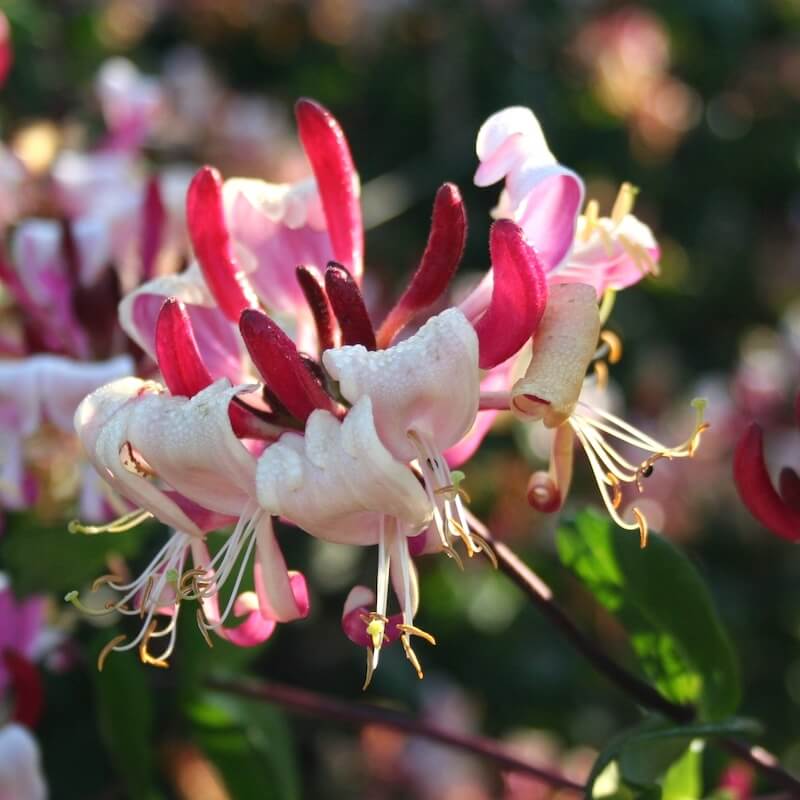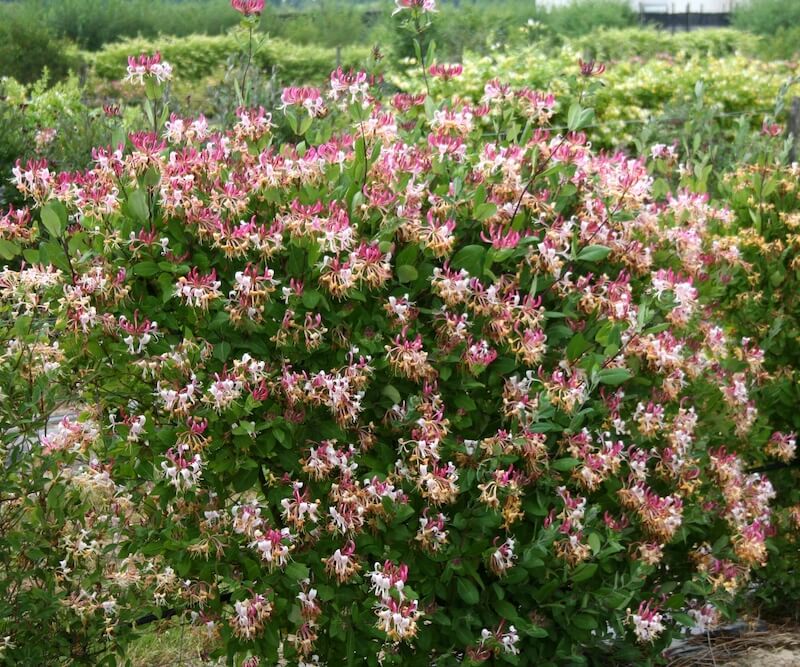
Position
- Full sun to partial shade
- All aspects – north, south, east, or west-facing
- Sheltered or moderately exposed sites
- Suitable for walls, fences, pergolas, and arbors
Hardiness
- Tolerates temperatures down to -20°C (-4°F)
- Fully hardy throughout UK
Soil
- Moist but well-drained soil
- Adapts to chalk, clay, sand, or loam
- Rich soil preferred
- Suits acid, alkaline, or neutral pH soils
- Grab a soil test kit and ensure the perfect conditions for growth
Height
- Height: 2.5 metres in 5-10 years
- Spread: 1-1.5 metres
Seasons of Interest
- Flowering period: June to October
- Deep red buds opening to cream flowers
- Extended flowering season
- Dark green foliage
- Red berries in autumn
- Strong sweet fragrance
Additional Notes
- Repeat flowering habit
- More compact than traditional varieties
- Highly disease resistant
- Excellent mildew resistance
- Strong vanilla-like evening scent
- Excellent for pollinators
- Regular pruning maintains shape
- Spring mulching is recommended
- Good for cutting gardens
- Perfect for cottage gardens
- Works well in containers
- Benefits from supporting structure
- Flowers earlier than many varieties
- Continues blooming into autumn
Lonicera Caprilia Imperial - A Compact Honeysuckle for Contemporary Gardens
For gardeners seeking a compact yet highly ornamental climber, Lonicera Caprilia Imperial is a modern twist on a classic favourite. This elegant honeysuckle cultivar combines creamy white blooms, rich fragrance, and a neatly contained growth habit that suits today’s smaller gardens and container displays. With excellent disease resistance and a long flowering period, it’s a wise, stylish choice for anyone looking to add vertical interest and wildlife appeal without overwhelming their outdoor space.
What Makes Lonicera Caprilia Imperial Unique?
One of the standout features of Caprilia Imperial is its exceptional floral display. The blooms emerge from striking burgundy-red buds and open into softly scented cream and pale pink flowers, creating a beautiful contrast against the plant’s dark green foliage. This rich colour transition adds dynamic visual appeal from early summer through midsummer.
With a compact, bushy growth habit that reaches approximately 2.5 metres (250cm) in height, this honeysuckle offers all the beauty of traditional varieties in a more manageable form. Its moderate size is particularly well-suited for small urban gardens, balconies, patios, or tight border spaces where limited space is still desired.
How and Where to Plant Caprilia Imperial
To give your honeysuckle the best start, plant it in fertile, moisture-retentive but well-drained soil. Like many Lonicera cultivars, it prefers a planting location where its roots remain cool and shaded while its upper growth can bask in full sun or light shade.
Before planting, enrich the soil with organic matter, such as compost or well-rotted manure, to enhance both fertility and structure. When planting, install a support structure, such as a trellis, arch, or obelisk, to provide stability and support. This will give the plant something to twine around, helping it grow upright with minimal guidance.
If planting in a container, choose a pot at least 40cm in diameter with good drainage holes. Use a loam-based compost, such as John Innes No. 3, and incorporate horticultural grit or crocks at the base to improve drainage and prevent waterlogging.
Ideal Growing Conditions for Strong, Healthy Growth
Caprilia Imperial is highly adaptable and performs well in a wide range of garden soils with adequate drainage. It’s hardy down to -20°C (-4°F), making it suitable for most parts of the UK, even in exposed gardens.
To mimic its natural conditions, keep the root zone shaded—perhaps with groundcover plants or mulch—while training the flowering stems into a sunny or lightly shaded position. This balance encourages abundant flowering and healthy foliage throughout the growing season.
Flowering Period and Seasonal Interest
The flowering season begins in June and extends through July, with clusters of beautifully scented flowers appearing in succession. These creamy white and blush pink blooms add elegance and colour, filling the air with their classic honeysuckle fragrance, particularly in the evening.
As summer gives way to autumn, Caprilia Imperial produces glossy red berries, adding late-season ornamental value and attracting garden birds. This extended period of interest makes it a valuable addition to any planting scheme focused on long-lasting beauty and seasonal diversity.

Maintenance and Pruning Tips
This honeysuckle is remarkably low-maintenance, but a few key tasks will keep it looking its best. Prune lightly after flowering to maintain a tidy, compact shape and to encourage new growth for the following season. Remove any dead, damaged, or overcrowded stems in late winter or early spring to improve air circulation and stimulate healthy shoots.
Applying a mulch of organic matter in spring will help retain moisture, reduce weed competition, and support sustained growth through dry periods. Container-grown plants benefit from regular feeding with a balanced liquid fertiliser during the growing season.
Growing Caprilia Imperial in Pots and Containers
Thanks to its restrained size and elegant form, ‘Caprilia® Imperial’ is ideal for container growth. Choose a deep, sturdy pot with ample drainage, and position it where the plant can climb or twine around a support.
Keep the compost evenly moist but not waterlogged, especially during hot spells. Feed regularly with a high-potash fertiliser (such as tomato feed) to encourage flowering, and refresh the top layer of compost each spring to replenish nutrients.
Supporting Wildlife in the Garden
This fragrant honeysuckle delights the eye and nose while supporting a diverse array of pollinators. Bees, butterflies, and hoverflies are drawn to the nectar-rich blooms during summer, making it a fantastic choice for eco-conscious gardeners aiming to boost biodiversity.
The bright red berries that follow in autumn offer a valuable food source for garden birds, including blackbirds and thrushes. Whether you’re creating a wildlife corridor or simply want to give nature a helping hand, Caprilia Imperial earns its place.
How to Propagate Lonicera Caprilia Imperial
Propagation is simple and rewarding. Softwood cuttings can be taken in early summer from non-flowering shoots, while hardwood cuttings are best taken in late autumn through winter once the plant is dormant.
Layering is another easy method: bend a low-growing stem to the ground, nick it lightly with a knife, peg it down, and cover with soil. It should have developed roots by the following spring and can be separated from the parent plant.
From Darren’s Patch
Caprilia Imperial is a go-to honeysuckle for smaller, more modern spaces. I grow it in a large pot by the back gate, where its fragrance greets you every time you walk past—especially in the evening when the scent seems strongest. It’s a joy to watch the buds shift from deep burgundy to soft cream and blush; the bees absolutely love it. What I appreciate most is how well-behaved it is—compact, tidy, and not prone to mildew like some of the older varieties. Whether gardening on a patio or tucking it into a small border with a trellis, it gives you all the classic cottage garden charm without the bulk. It’s a real gem.
![]()
Key Points to Remember:
- Compact growth is ideal for smaller spaces
- Flowers June-July with red buds opening to cream
- Hardy to -20°C
- Plant in sun or partial shade
- Regular pruning maintains shape
- Excellent for containers
- Attracts wildlife
- Disease resistant
- Fragrant flowers
- Easy to maintain
Whether you’re creating a compact wildlife haven, refreshing a container display, or adding vertical interest to a smaller garden, Lonicera periclymenum Caprilia Imperial delivers on every front. With its rich fragrance, striking blooms, and manageable size, this modern honeysuckle offers the charm of a cottage garden classic in a refined, space-saving form. Easy to grow, low in maintenance, and loved by pollinators and birds alike, it’s a superb choice for gardeners looking to combine ornamental value with ecological benefit. If you’re after a honeysuckle that fits seamlessly into contemporary planting schemes, Caprilia® Imperial is hard to beat.
Check out the RHS article here.
Explore our full collection of planting guides for expert advice on climbers and wall shrubs.
Want to learn about other climbers? Read about Lonicera Chic et Choc here.
Frequently Asked Questions
Q: What is the description of Lonicera periclymenum Caprilia Imperial?
A: Lonicera Caprilia Imperial is a stunning climbing honeysuckle, known for its beautiful red and cream-coloured flowers. This deciduous climber blooms from late spring to summer, producing fragrant flowers that attract bees and butterflies. It has a lovely sweet scent and can grow several metres high when properly trained.
Q: How do I propagate Lonicera periclymenum Caprilia Imperial?
A: You can propagate ‘Caprilia Imperial’ through cuttings or layering. For cuttings, take a shoot in early summer, dip it in rooting hormone, and plant it in well-draining soil. Keep it moist until roots develop. If you’re layering, bend a stem to the ground, cover part of it with soil, and it will root itself over time!
Q: Does Lonicera periclymenum Caprilia Imperial prefer full sun or shade?
A: This beautiful climber does best in partial shade but can tolerate full sun as long as it has sufficient moisture. It’s perfect for areas that receive some morning sun and afternoon shade, helping to keep the soil cool and damp.
Q: What are some related products to Lonicera periclymenum Caprilia Imperial?
A: If you love ‘Caprilia Imperial’, you might want to check out other climbing plants like clematis or other varieties of honeysuckle. Also, consider adding companion plants that thrive in similar conditions to create a perfect garden setup.
Q: How tall can Lonicera periclymenum Caprilia Imperial grow?
A: This climbing honeysuckle can grow quite tall, often reaching heights of several metres if given the right support. It’s ideal for training on trellises, fences, or walls to create a beautiful, fragrant display.
Q: When does Lonicera periclymenum Caprilia Imperial bloom?
A: You can expect a stunning bloom from late spring to the end of summer. The beautiful red flowers will make your garden pop and fill the air with their delightful fragrance, attracting pollinators.
Q: Is Lonicera periclymenum Caprilia Imperial suitable for my garden?
A: Absolutely! This climbing honeysuckle is a great choice for most gardens, especially if you have space for it to climb. Just provide some support and monitor its growth. It’s suitable for various climates and can adapt well as long as it’s not in overly harsh conditions.
Q: Are the flowers of Lonicera periclymenum Caprilia Imperial fragrant?
A: Yes, the flowers are known for their lovely fragrance! The sweet scent of the blooms makes it an excellent choice for gardens where you want to enjoy the aroma, especially during the spring and summer months.
Q: What is the best way to train Lonicera periclymenum Caprilia Imperial to climb?
A: To train this climber, use garden ties or twine to attach the stems to a trellis or support structure. Regularly check and adjust the ties as the plant grows, and gently guide the shoots in the desired direction to promote healthy climbing.
All images © Plantipp BV®
